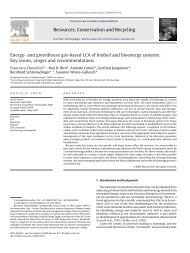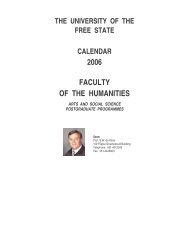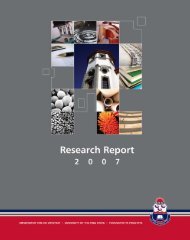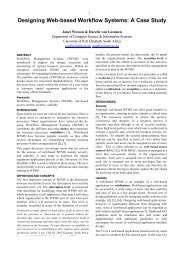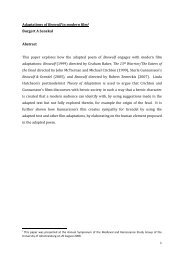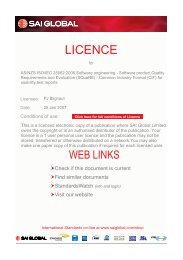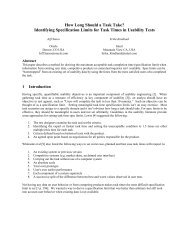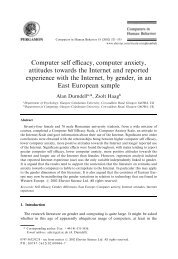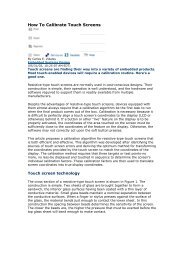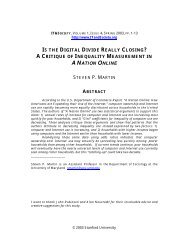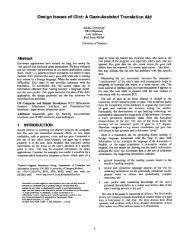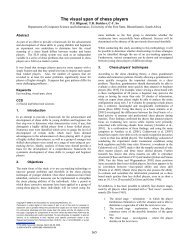the role of livestock in developing communities: enhancing ...
the role of livestock in developing communities: enhancing ...
the role of livestock in developing communities: enhancing ...
You also want an ePaper? Increase the reach of your titles
YUMPU automatically turns print PDFs into web optimized ePapers that Google loves.
6. Research and development needs must be derived from <strong>the</strong> community. Community members must<br />
become research facilities and must drive <strong>the</strong> research process (i.e. ‘put <strong>the</strong> community beh<strong>in</strong>d <strong>the</strong><br />
steer<strong>in</strong>g wheel’).<br />
• However, researchers do not necessarily have <strong>the</strong> skills required to do this. The challenge here is<br />
to discover how researchers can acquire <strong>the</strong>se skills.<br />
7. The presentation is applicable to both developed and develop<strong>in</strong>g countries, because similar farm<strong>in</strong>g<br />
transitions and similar knowledge needs exist <strong>in</strong> both worlds.<br />
8. The application <strong>of</strong> <strong>the</strong> ‘tree model’ expla<strong>in</strong>ed <strong>in</strong> <strong>the</strong> presentation <strong>in</strong> different learn<strong>in</strong>g <strong>communities</strong><br />
(<strong>in</strong> both <strong>in</strong> developed and develop<strong>in</strong>g countries) may be challeng<strong>in</strong>g, especially where colleagues are<br />
more discipl<strong>in</strong>e-oriented and/or less familiar/comfortable with <strong>the</strong> use <strong>of</strong> systems approaches.<br />
• One solution is to help students with separate discipl<strong>in</strong>ary perspectives (i.e. with little <strong>in</strong> common)<br />
to work and learn toge<strong>the</strong>r <strong>in</strong> groups. This provides excellent <strong>in</strong>terdiscipl<strong>in</strong>ary tra<strong>in</strong><strong>in</strong>g and<br />
students who have conversations learn from each o<strong>the</strong>r <strong>in</strong> a way that <strong>the</strong>y would not have o<strong>the</strong>rwise.<br />
• Ano<strong>the</strong>r solution id to constitute multidiscipl<strong>in</strong>ary study-lead<strong>in</strong>g teams (committees) to advise<br />
students (<strong>in</strong>stead <strong>of</strong> s<strong>in</strong>gle supervisors, or a group from with<strong>in</strong> a s<strong>in</strong>gle discipl<strong>in</strong>e).<br />
9. Susta<strong>in</strong>ability is threatened when <strong>the</strong> objectives <strong>of</strong> different stakeholders (researchers, funders,<br />
community members, public and private sector organisations etc.) are not aligned. The challenge is to<br />
facilitate a shared goal among partners, to enable susta<strong>in</strong>ability.<br />
• This aspect is also affected by <strong>the</strong> short-term fund<strong>in</strong>g <strong>of</strong> projects with long-term goals.<br />
10. Ensur<strong>in</strong>g relevant decision-mak<strong>in</strong>g (by identify<strong>in</strong>g and appropriately <strong>in</strong>form<strong>in</strong>g <strong>the</strong> ‘decision-makers’)<br />
is a fur<strong>the</strong>r challenge.<br />
11. Even though understand<strong>in</strong>g <strong>the</strong> needs, aspirations, knowledge and requirements <strong>of</strong> a target group (be it<br />
<strong>the</strong> farmer or policy-maker) takes a lot <strong>of</strong> time and effort, it rema<strong>in</strong>s critically important to research.<br />
12. Community members should not only be <strong>in</strong>cluded <strong>in</strong> problem identification. There <strong>in</strong>digenous<br />
knowledge should also be actively utilised <strong>in</strong> identify<strong>in</strong>g solutions. i.e. <strong>in</strong>stead <strong>of</strong> driv<strong>in</strong>g new<br />
technologies, first try to identify local technologies to solve local problems.<br />
13. Susta<strong>in</strong>ability is cont<strong>in</strong>u<strong>in</strong>g development. Grassroots problems must be addressed through cont<strong>in</strong>u<strong>in</strong>g<br />
development <strong>of</strong> <strong>the</strong> community’s ability to study <strong>the</strong>ir own problems and to assist each o<strong>the</strong>r.<br />
• The development <strong>of</strong> susta<strong>in</strong>ability <strong>in</strong>dicators for specifically <strong>the</strong> contribution <strong>of</strong> animal production<br />
to <strong>the</strong> quality <strong>of</strong> life <strong>of</strong> <strong>communities</strong> must be <strong>in</strong>vestigated.<br />
14. In terms <strong>of</strong> <strong>the</strong> noted challenges and solutions, we must consider who benefits with<strong>in</strong> this development<br />
community (i.e. <strong>the</strong> researcher, <strong>the</strong> farmer, <strong>the</strong> animal or <strong>the</strong> funder). This begs <strong>the</strong> question: who holds<br />
<strong>the</strong> power, and do <strong>the</strong>y ma<strong>in</strong>ta<strong>in</strong> an altruistic attitude or a capitalist attitude?<br />
Proceed<strong>in</strong>gs <strong>of</strong> <strong>the</strong> Satellite Symposium: WCAP 9



